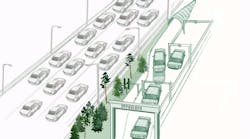Next Steps on Infrastructure
The long-anticipated federal infrastructure bill is making progress in the U.S. Senate. While there still are concerns over the $1 trillion price tag amid a general atmosphere of distrust in Washington, there’s little argument that roads, bridges and other transportation systems need a massive overhaul.
The bill has a number of provisions to address the aging infrastructure, but there are secondary benefits of federal and state funds being pooled to repair the transportation system. There will need to be new investment in manufacturing to deliver the materials and equipment needed for these massive projects and a fresh look at how transportation, supply chains and communications will change in the next two decades.
An infrastructure plan that repairs the existing systems is essential, but it is only a start. A vision of the networks we will need to move forward on such issues as electrification and autonomous driving also must be a part of the planning and execution that comes from this expenditure.
Planning Already is Underway
The need for a look at the needs for infrastructure in the future is hardly a new one. Meet George Jetson, for example. Or take a look at this story from 2017, where the Association of Equipment Manufacturers handed out thousands of dollars in grants for proposals to develop solutions for high-speed rail, autonomous driving and even a self-adjusting pavement system.
Another key component of future infrastructure is a way to identify when and where repairs are needed.
As Machine Design reported, the National Institute of Standards and Technology (NIST) is using a novel form of x-rays to detect corrosion, the primary danger threatening the health of the steel framework within the nation’s bridges, roads and other aging physical infrastructure. This noninvasive “spectral fingerprint” technique reveals the corrosion of concrete-encased steel before it can cause any significant degradation of the structure it supports.
“The brown rust that forms when you leave a hammer out in the rain is mostly goethite, and when a steel reinforcing bar or rebar corrodes inside a concrete bridge deck, that is mostly hematite,” said NIST physical chemist Dave Plusquellic. “We have shown that terahertz radiation—electromagnetic waves with frequencies 10 to 100 times higher than microwaves used to cook food—detects both corrosion products in the early stages of formation.”
About the Author

Bob Vavra
Editor Emeritus, Machine Design and Power & Motion
Bob Vavra is the former senior content director of Machine Design and Power & Motion.
